
| Version | Summary | Created by | Modification | Content Size | Created at | Operation |
|---|---|---|---|---|---|---|
| 1 | Alessandra Ferramosca | + 1085 word(s) | 1085 | 2021-09-10 09:42:14 | | | |
| 2 | Alessandra Ferramosca | + 15 word(s) | 1100 | 2021-09-22 17:25:06 | | | | |
| 3 | Catherine Yang | + 19 word(s) | 1104 | 2021-09-23 02:38:59 | | |
Video Upload Options
Mitochondrial carriers play a fundamental role in cellular metabolism, connecting mitochondrial with cytosolic reactions. By transporting substrates across the inner membrane of mitochondria, they contribute to many processes that are central to cellular function. The genome of Saccharomyces cerevisiae encodes 35 members of the mitochondrial carrier family, most of which have been functionally characterized.
1. Introduction
Table 1. List of mitochondrial carriers from Saccharomyces cerevisiae. Alternative carrier names are in brackets.
|
Carrier |
Substrates Transported |
Function/Metabolic Pathway |
|
|
ADP/ATP carrier |
Aac1p Aac2p Aac3p |
ADP, ATP |
Oxidative phosphorylation |
|
ADP/ATP carrier (peroxisomal) |
Ant1p |
ATP, AMP |
Lipid metabolism |
|
Adenosine 5′-phosphosulfate carrier |
Apsc1p |
Adenosine 5’-phosphosulfate 3’-phospho-adenosine 5’-phosphosulfate, sulfate, and phosphate |
Thermotolerance and synthesis of methionine and glutathione at elevated temperatures |
|
ATP-Mg/phosphate carrier |
Sal1p |
ADP, ATP, ATP-Mg, and Pi (Ca2+-stimulated) |
Glucose-induced calcium signal |
|
Aspartate/glutamate carrier |
Agc1p Ymc1p Ymc2p
|
Aspartate, glutamate
|
Nitrogen metabolism and ornithine synthesis Malate-aspartate NADH shuttle |
|
Carnitine carrier |
Crc1p |
Carnitine, acetyl-carnitine, and propionyl-carnitine (medium- and long-chain acyl-carnitines less efficiently) |
Lipid metabolism |
|
Citrate carrier |
Ctp1p |
Citrate, tricarboxylates |
Lipid and glucose metabolism |
|
Citrate/oxoglutarate carrier |
Yhm2p (Coc1p) |
Citrate, oxoglutarate (oxaloacetate, succinate, and fumarate less efficiently) |
Increase in the NADPH reducing power in the cytosol Component of the citrate-oxoglutarate NADPH redox shuttle |
|
Coenzyme A carrier |
Leu5p |
Coenzyme A |
Distribution of Coenzyme A |
|
Dicarboxylate carrier |
Dic1p |
Dicarboxylates (malate, succinate, or malonate), Pi, sulfate, and thiosulfate |
Anaplerotic role for the Krebs cycle |
|
FAD carrier |
Flx1p |
FAD |
Flavin transport |
|
GTP/GDP carrier |
Ggc1p |
GTP, GDP, dGTP, dGDP, and the structurally related ITP and IDP (guanosine 5′-tetraphosphate and the (deoxy)nucleoside di- and triphosphates of U and T less efficiently) |
Protein synthesis and RNA synthesis |
|
Magnesium carrier |
Mme1 |
Magnesium |
Homeostasis of magnesium |
|
NAD+ carrier |
Ndt1p Ndt2p |
NAD+ (dAMP and dGMP, NADH, NADP+, or NADPH less efficiently) |
Import NAD+ into mitochondria |
|
Iron carrier |
Mrs3p Mrs4p |
Iron |
Iron accumulation |
|
Ornithine carrier |
Ort1p |
Ornithine/H+ or ornithine/ornithine (arginine and lysine less efficiently) |
Arginine synthesis |
|
Oxaloacetate carrier |
Oac1p |
Oxaloacetate, sulfate, and a-isopropylmalate (various substrates of the dicarboxylate and oxoglutarate carriers less efficiently) |
Anaplerotic role for the Krebs cycle Leucine synthesis |
|
Oxodicarboxylate carrier |
Odc1p Odc2p |
Oxoadipate, oxoglutarate (dicarboxylates and malate less efficiently) |
Nitrogen assimilation Malate/aspartate shuttle |
|
Phosphate carrier |
Mir1p Pic2p |
Phosphate |
Oxidative phosphorylation |
|
Pyridoxal 5’-phosphate transporter |
Mtm1p |
Pyridoxal 5’-phosphate transporter |
Pyridoxal 5’-phosphate trafficking Iron homeostasis |
|
Pyrimidine nucleotide carrier |
Pyt1p (Rim2p) |
Pyrimidine (deoxy)nucleoside mono-, di- and triphosphates |
mtDNA and mtRNA synthesis |
|
S-adenosylmethionine carrier |
Sam5p |
S-adenosylmethionine |
Biosynthesis of biotin and lipoic acid Methylation reactions of mtDNA, mtRNA, and mitochondrial proteins |
|
Succinate/fumarate carrier |
Sfc1p |
Succinate, fumarate |
Gluconeogenesis |
|
Thiamine pyrophosphate carrier |
Tpc1p |
Thiamine pyrophosphate, thiamine monophosphate ((deoxy)nucleotides less efficiently) |
Branched chain amino acids synthesis |
|
|
Ugo1p |
|
Mitochondrial fusion |
|
|
YDL119c (Hem25) |
Glicine |
Heme synthesis |
|
|
YFR045w product |
? |
? |
With a single exception, these proteins are found in the inner membranes of mitochondria. By transporting several substrates across this membrane, they are indirectly involved in many biochemical processes, such oxidative phosphorylation (OXPHOS) ( Figure 1 ), the transfer of reducing equivalents ( Figure 2 ), the transport of Krebs cycle intermediates ( Figure 3 ), fatty acid metabolism ( Figure 4 ), gluconeogenesis (Figure 5), and amino acid synthesis ( Figure 6 ).
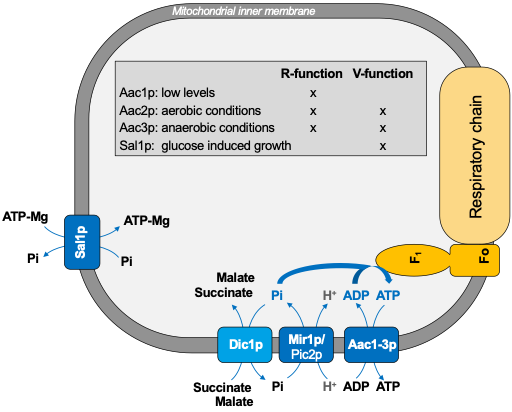
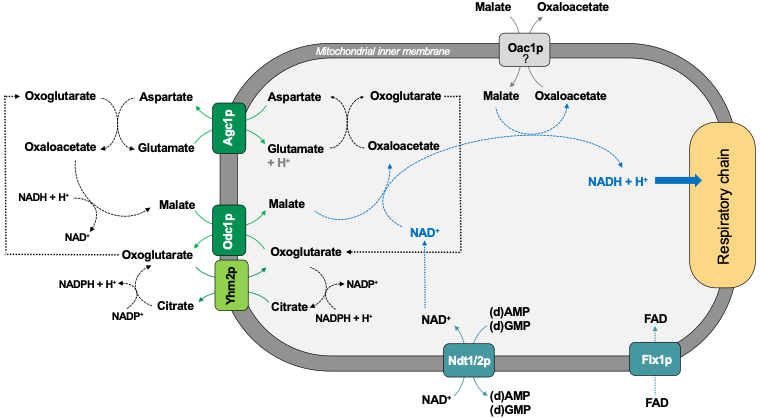 Figure 2. Transport of reducing equivalents into mitochondria.
Figure 2. Transport of reducing equivalents into mitochondria.
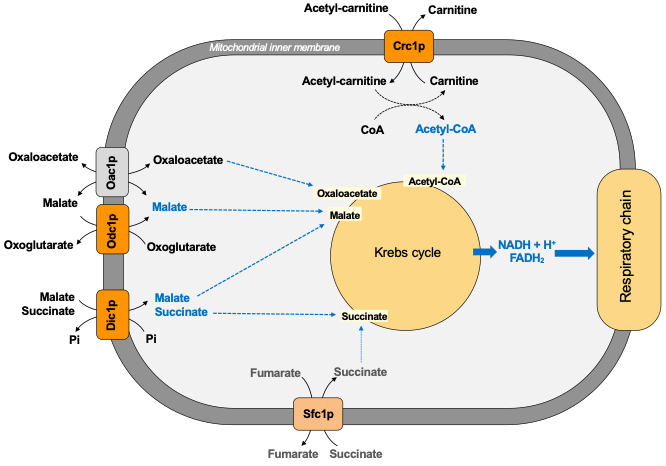
Figure 3. Mitochondrial carriers and transport of Krebs cycle intermediates.
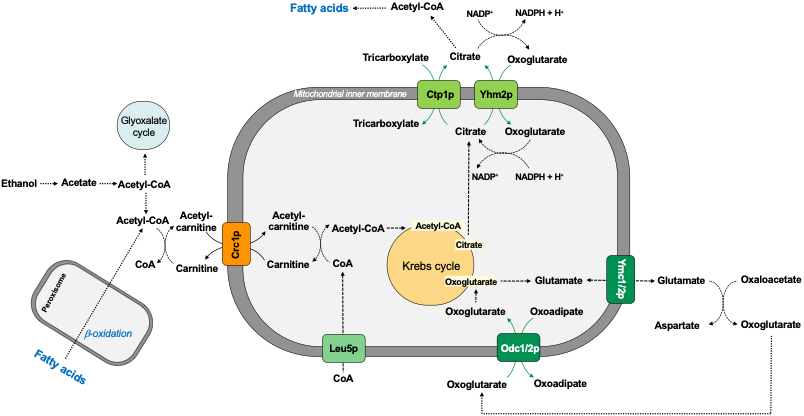
Figure 4. Mitochondrial carriers and lipid metabolism.
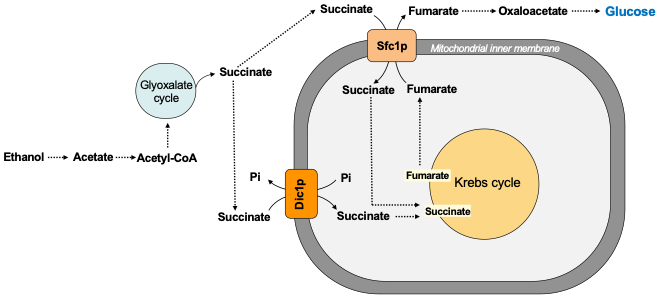 Figure 5. Mitochondrial carriers and gluconeogenesis.
Figure 5. Mitochondrial carriers and gluconeogenesis.
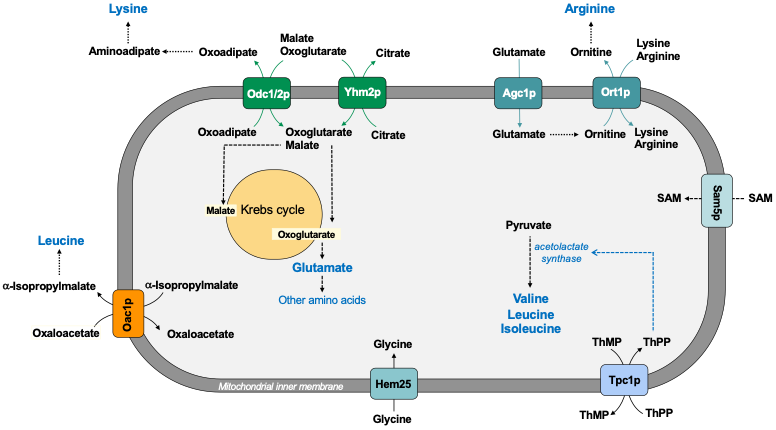 Figure 6. Mitochondrial carriers and amino acid synthesis.
Figure 6. Mitochondrial carriers and amino acid synthesis.
2. Role and application
Taken together, all this evidence suggests that mitochondrial carriers play a key role in the adaptation of yeast metabolism in response to specific growth conditions. Their involvement in metabolic pathways can provide new insights not only on the physiological roles of mitochondrial carriers in yeast cell metabolism but also in the understanding of molecular basis of human diseases. However, many questions remain to be addressed. In fact, some carrier proteins possess specific isoforms which possess different physiological roles. At the same time, different carrier proteins can transport the same substrates depending on metabolic condition of the cell. What, when, and how much are these proteins expressed? Are these proteins distributed in the mitochondrial inner membrane, or are they localized to create specific carrier clusters associated to specific metabolic pathways? Is there a physical interaction between carrier proteins contributing to the same biochemical process? How are these proteins orchestrated to channel substrates to common pathways? These unexplored aspects are very intriguing, and more research is required to highlight new findings in the field of mitochondrial carrier biology in the yeast Saccharomyces cerevisiae.




